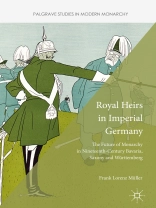This book explores the development and viability of Germany’s sub-national monarchies in the decades before their sudden demise in 1918. It does so by focusing on the men who turned out to be the last ones to inherit the crowns of the country’s three smaller kingdoms: Prince Ludwig of Bavaria, Prince Friedrich August of Saxony and Prince Wilhelm of Württemberg. Imperial Germany was not a monolithic block, but a motley federation of more than twenty allied regional monarchies, headed by the Kaiser. When the German Reich became a republic at the end of the First World War, all of these kings, grand dukes, dukes and princes were swept away within a fortnight. By examining the lives, experiences and functions of these three men as heirs to the throne during the decades when they prepared themselves for their predestined role as king, this study investigates what the future of the German model of constitutional monarchy looked like before it was so abruptly discarded.
Зміст
List of Illustrations.- Acknowledgements.- 1. Introduction.- 2. Symptoms of the
“unnaturalness of an institution”? Trials and tribulations on the way to the throne.- 3.
“The love of the people … needs to be acquired.” Competence and the paths of monarchical persuasion.- 4.
‘I and my house
feel at one with my people!”
Telling the tale of a popular tribal monarchy.- 5.
“We do not want to be regarded as lesser brothers” Royal heirs in the German Reich and the challenges of particularism.- 6.
“My government will …” Variations on a future theme.- 7. Conclusion.- Bibliography
Про автора
Frank Lorenz Müller teaches Modern History at the University of St Andrews, UK. He works on nineteenth-century European history and specializes in the history of monarchy. In 2011 he published
Our Fritz:
Emperor Frederick III and the Political Culture of Imperial Germany. Together with Heidi Mehrkens he has edited
Sons and Heirs:
Succession and Political Culture in Nineteenth-Century Europe (2015) as well as
Royal Heirs and the Uses of Soft Power in Nineteenth-Century Europe (2017).












